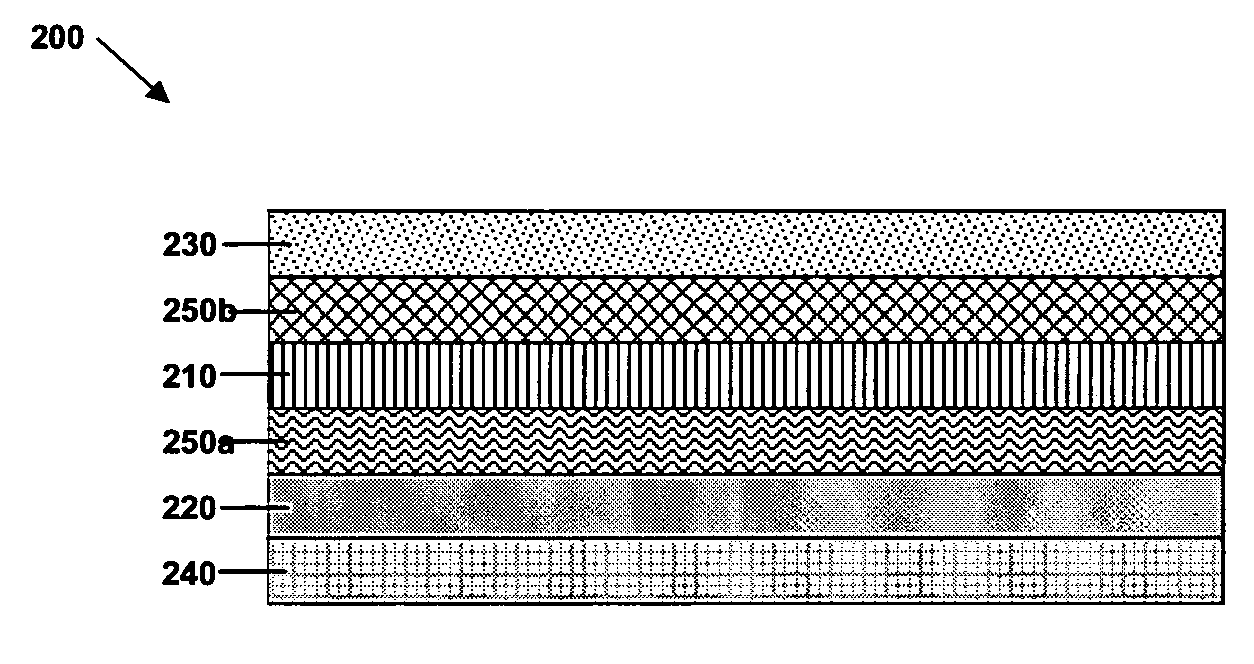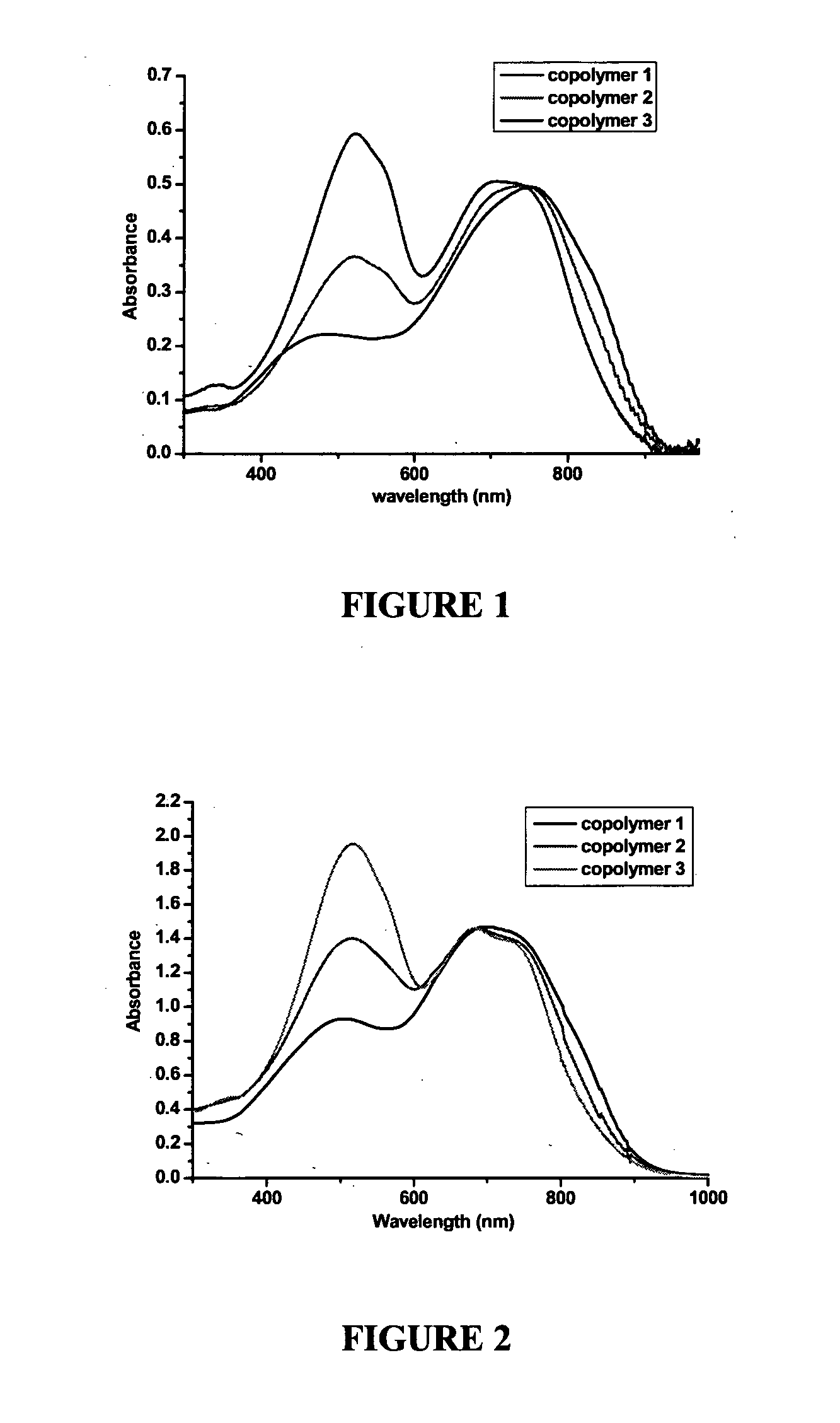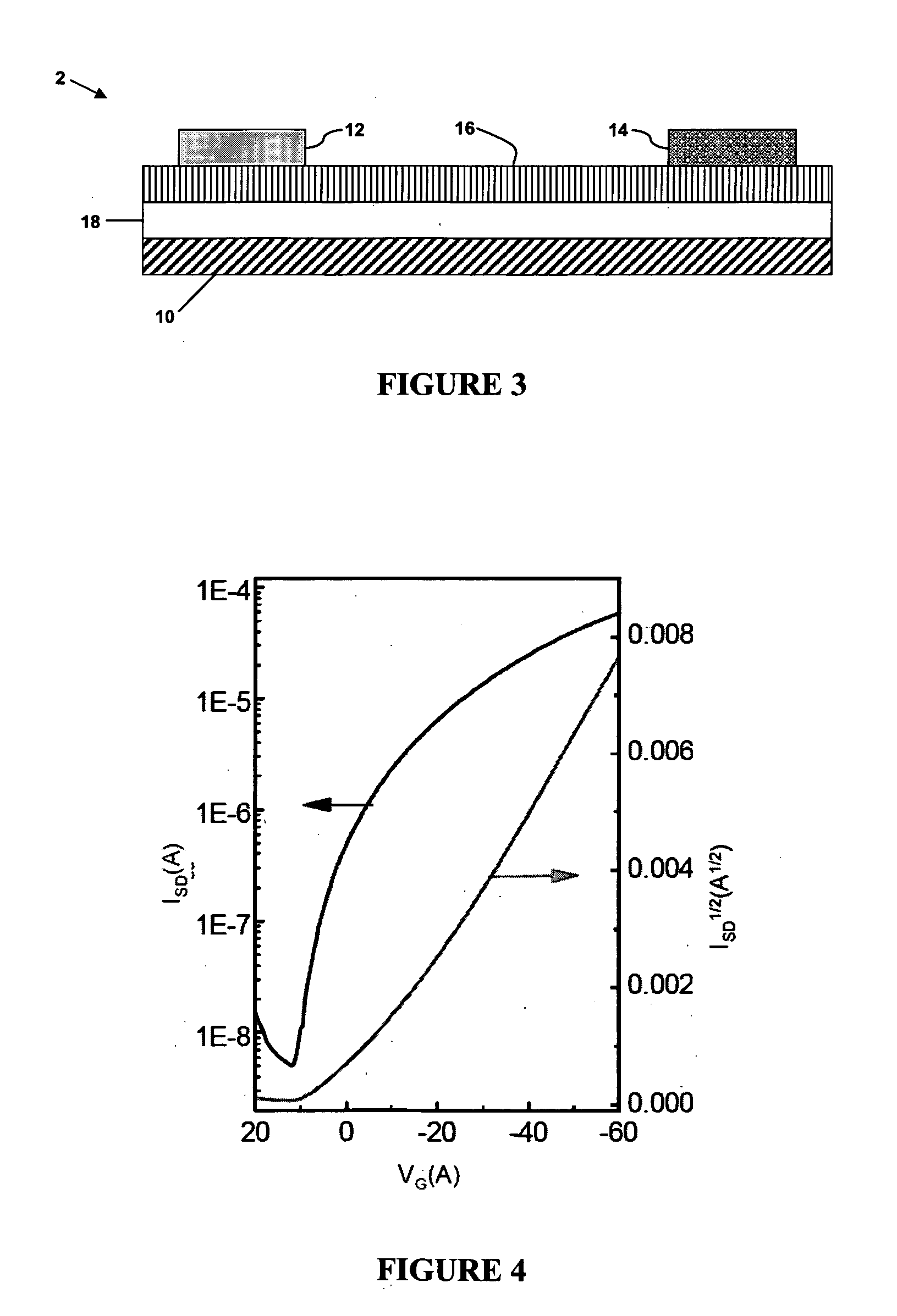P-type materials and organic electronic devices
a technology of organic electronic devices and materials, applied in the direction of non-metal conductors, conductors, thermoelectric devices, etc., can solve the problems of poor matching of photon absorbance with solar spectrum, decrease of open circuit voltage, and power conversion efficiency reduction, so as to facilitate molecular packing, facilitate molecular packing, and wide absorption spectra
- Summary
- Abstract
- Description
- Claims
- Application Information
AI Technical Summary
Benefits of technology
Problems solved by technology
Method used
Image
Examples
example 1
Synthesis of Compound 1 (DD-DPP)
[0116]Compound 1 was synthesized as set out in Scheme 1 below.
[0117]The starting precursor compound, 5-dihydro-1,4-dioxo-3,6-dithienylpyrrolo[3,4-c]-pyrrole (DPP) was synthesized in good yield following a previously reported procedure which involves reaction of 2-thiophenecarbonitrile with 0.5 eq of di-n-butyl succinate ester and an excess of potassium t-butoxide using 2-methyl-2-butanol as solvent. To prepare soluble derivative 3,6-bis-[2,2′]bithiophenyl-5-yl-2,5-di-n-dodecylpyrrolo[3,4-c]pyrrole-1,4-dione (DD-DPP), further alkylation of DPP was performed using 3 equivalents of n-dodecylbromide with 3 eqivalents of anhydrous K2CO3 in presence of anhydrous DMF solvent. Alkylated DPP was additionally dibrominated with N-bromosuccinimide in anhydrous chloroform and crude compound was purified by column chromatography using chloroform as eluent and the overall yield was recorded around 40%. 1H NMR (CDCl3): d 0.88 (t, 6H), 1.18-1.47 (m, 36H), 1.75 (m, 4H)...
example 2
Synthesis of Compounds 2 to 8
[0118]Compounds 2 to 8 were synthesized as set out in Scheme 2 below.
[0119]3-Bromo-6-pentadecyl-thieno[3,2-b]thiophene (2) was prepared according to the published procedure [Yuning Li, Yiliang Wu, Ping Liu, Maria Birau, Hualong Pan, and Beng S. Ong, Adv. Mater. 2006, 18, 3029-3032].
[0120]Synthesis of 1-(3-bromo-6-pentadecyl-thieno[3,2-b]thiophen-2-yl)-pentadecan-1-ol (3): Lithium diisopropylamide solution (15 mL, 0.03 mol, 2M in tetrahydrofuran) was added dropwise to a solution of 6-bromo-3-pentadecylthieno[3,2-b]thiophene (10.8 g, 0.025 mol) and THF (150 mL) in ice-water bath and kept stirring for 2 hrs, then the reaction was quenched by hexadecyl aldehyde (6 g, 0.025 mol). The mixture was stirred overnight and quenched with water. After evaporating most of THF, 150 mL methylene chloride was added and mixture was washed with brine (2×100 mL), water (100 mL) and dried over anhydrous MgSO4. The product was obtained by column chromatography on silica gel, ...
example 3
Synthesis of Copolymers 1, 2, 3
[0126]Copolymers 1, 2, 3 were synthesized as set out in Scheme 3.
[0127]Synthesis of Copolymer 1 (m / n=1 / 1): To a Schlenk flask was added 2,5-Bis(trimethylstannanyl)thiophene (2 equivalent, 65.2 mg, 0.16 mmol), 2,6-dibromo-3,5-dipentadecyl-dithieno[3,2-b;2′,3′-d]thiophene (1 equivalent, 61.6 mg, 0.08 mmol), compound 1 (1 equivalent, 63 mg, 0.08 mmol), tri(o-toyl) phosphine (16 mol % equivalent, 3.87 mg, 0.0128 mmol), tris(dibenzylideneacetone)dipalladium (4 mol % equivalent, 2.9 mg, 0.0032 mmol) and dry chlorobenzene (30 ml) under the protection of nitrogen. The flask was securely sealed and stirred for 72 h at 120° C. After cooling to room temperature, the reaction mixture was precipitated into a mixture of methanol (100 ml) and concentrated hydrochloric acid (4 ml) and stirred for 16 h. The precipitate was collected, Soxhlet extracted with ethanol and hexane for 48 h each, and dried under vacuum afford the bulk product (90 mg, 75% yield).
[0128]Synthesi...
PUM
| Property | Measurement | Unit |
|---|---|---|
| hole mobility | aaaaa | aaaaa |
| thick | aaaaa | aaaaa |
| thick | aaaaa | aaaaa |
Abstract
Description
Claims
Application Information
 Login to View More
Login to View More - R&D
- Intellectual Property
- Life Sciences
- Materials
- Tech Scout
- Unparalleled Data Quality
- Higher Quality Content
- 60% Fewer Hallucinations
Browse by: Latest US Patents, China's latest patents, Technical Efficacy Thesaurus, Application Domain, Technology Topic, Popular Technical Reports.
© 2025 PatSnap. All rights reserved.Legal|Privacy policy|Modern Slavery Act Transparency Statement|Sitemap|About US| Contact US: help@patsnap.com



